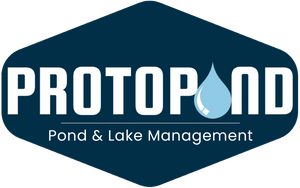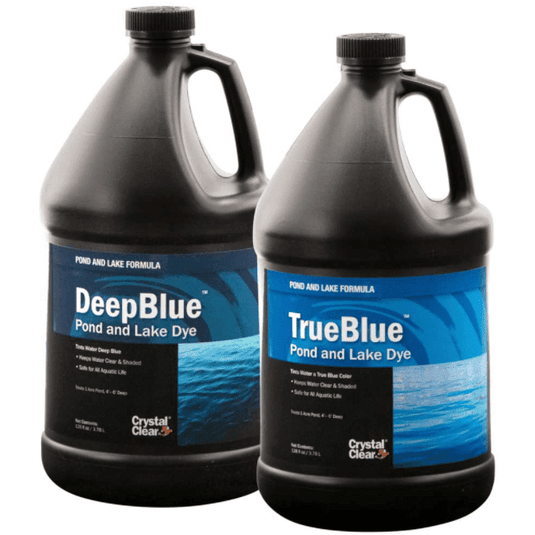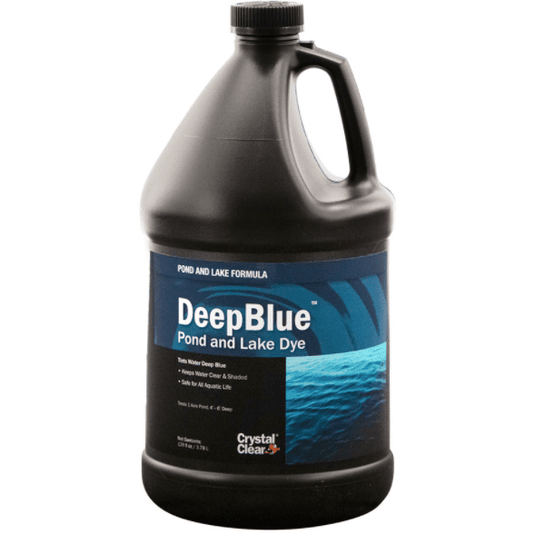Collection: Pond Dye 2 products
Pond dyes operate by coloring and tinting the water in deep blue, black, or blue-green pond dye colors. Not only can tinting your pond's water hide that brown or greenish appearance, but it also serves as a sunscreen for your lake or pond, blocking out too much sunshine. This UV blockage retard the process of photosynthesis, natural stimulation that often helps algae and weeds grow in a pond.
Depending on the size of your pond, we advise using the recommended quantity on the box or less. Our objective is to provide a light tint that will help reduce light penetration while being aesthetically pleasant and allowing some view into the pond. To get the desired effects, you might have to experiment with the dosage.
Not sure what pond color dye is for you? While many people still prefer and love the traditional blue pond dye, black dye and the mix of blue and black pond dye have become more and more popular in recent years. Many people, including us, think that incorporating a little black in the mixture gives a more natural Aqua shade pond dye than just using blue.
Any type of pond dye can aid in keeping fish safe from predatory birds' harm, or death. Valuable Koi, cruising trout, and spawning game fish are the target of wading and diving birds like the blue heron. If you apply too much, stop adding. As an alternative, wait to add further pond shade dye for four to eight weeks. Pond dye typically has a two-month shelf life.
When applying it, you should always wear gloves and protective clothes because the dye might stain your skin and clothes. This particularly applies to dyes that are undiluted.
Many people continue to like and enjoy the standard blue coloration, however in recent years, black dye has been gaining in popularity, as has the combination of blue and black colors. By adding a bit of black to the mixture, many people (us included) believe that these provide a more natural appearance compared to using blue alone.
The duration of many dye products is often a month or more long, however, this can be affected by water turnover in your pond to some extent. For most ponds, the dyes will last for a number of weeks.
We don't view pond dye as a full preventative for unwanted plant growth. Sometimes it is, however, it usually works best in combination with beneficial bacteria or other treatments. It is particularly helpful in shallow ponds of 6 feet or less.
How do Pond Dyes Work?
Pond dyes work by coloring and tinting the water a shade of dark blue, black, or blue-green. Tinting your pond water not only covers the brown or greenish look, but it acts as a sunscreen for your pond or lake, keeping out excess sunlight. UV rays can damage your beneficial bacteria.
When using Beneficial Bacteria Products it is a good idea to use pond dye to block excessive sunlight that would harm the bacteria you are trying to propagate to consume your excess muck and organic nutrients.
More Information
Pond Dye: The Essential Guide
Ponds can be a beautiful addition to any landscape. However, they may not always look as good as they could. Over time, ponds can develop unsightly algae, weeds, and other issues that make them less appealing. One solution to this problem is the use of pond dye. In this guide, we will explore why pond dye is essential for keeping your pond healthy and looking its best.
What is Pond Dye?
Pond dye is a liquid or powder that is added to water to change its color. It is made from natural or synthetic pigments. The dye does not harm the fish, plants, or animals in the pond. It works by blocking sunlight, which helps reduce algae growth and gives the pond a more attractive appearance.
For a more detailed explanation, check out this guide about pond dyes.
Why Should You Use Pond Dye?
Reduces Algae Growth
Algae can be a big problem for ponds. It thrives when there is too much sunlight. Pond dye helps by blocking some of the sun's rays from reaching the water. This reduction in sunlight makes it harder for algae to grow.
Improves Water Quality
The dye helps maintain the water’s quality by reducing the growth of algae. As algae grow, they consume oxygen and release harmful substances into the water. This can harm fish and other pond life. By using pond dye, you are promoting a healthier environment for all living things in your pond.
Enhances Aesthetics
A pond that is free of algae and weeds looks much more beautiful. Pond dye helps improve the water’s color, giving it a rich, blue or green hue. This not only makes the pond look nicer, but it also helps it blend better with the surrounding landscape.
Protects Fish and Wildlife
By limiting algae growth, pond dye creates a more balanced ecosystem for fish and other wildlife. Algae blooms can deplete oxygen levels in the water, which can be harmful or even deadly to fish. Pond dye reduces this risk.
How Does Pond Dye Work?
Pond dye works by absorbing sunlight that would normally reach the water’s surface. When sunlight is blocked, less light reaches the plants in the pond, which in turn reduces the chance for algae to grow. The dye also helps maintain a cooler water temperature, which is beneficial for fish and other aquatic life.
It’s important to note that pond dye doesn't kill algae. Instead, it works as a preventive measure to keep algae from flourishing. If your pond is already suffering from an algae bloom, you may need to use a treatment that specifically targets algae in addition to the pond dye.
Types of Pond Dye
There are a few different types of pond dye available, and each has its own benefits.
Blue Pond Dye
This is the most common type of pond dye. It gives the water a clean, blue appearance. Blue dyes are usually used for ponds with a lot of sunlight exposure.
Black Pond Dye
Black pond dye gives the water a dark, rich color. It is particularly useful for ponds that have a lot of organic matter or weeds. The dark color also helps to hide the bottom of the pond.
Green Pond Dye
Green pond dye is best for ponds with low to moderate sunlight. It gives the pond a more natural, green look. Green dyes also help in reducing the growth of algae and other plants.
Looking for a trusted product? Try the Scott Aerator Pond Dye Concentrated Liquid, available at Protopond. It's highly effective and safe for aquatic life.
How to Apply Pond Dye
Applying pond dye is simple. You can use a liquid form, which is easier to mix, or a powder that is more concentrated. Most pond dye comes with instructions, so be sure to follow them carefully.
Here are the basic steps for applying pond dye:
1. Choose the Right Dye
First, determine the color that suits your pond best. Consider the amount of sunlight your pond gets and the type of appearance you want.
2. Measure the Pond’s Size
To ensure the right amount of dye, you need to know how much water your pond holds. This is usually measured in gallons. Larger ponds will require more dye.
3. Add the Dye
Pour the dye evenly around the edges of the pond. It will spread out across the water. Be sure not to add too much at once. You can always add more if needed.
4. Wait for the Dye to Settle
After adding the dye, allow it to settle for 24 to 48 hours. During this time, the color will intensify, and you’ll begin to notice a reduction in algae.
When to Use Pond Dye
Pond dye is best applied in early spring before the hot summer months. This is when algae growth is most likely to occur. If you live in an area with lots of sunlight, you may want to apply pond dye every few weeks throughout the year.
It’s also important to use pond dye after major pond cleanings or when the pond is newly filled with water. This helps establish the right environment for healthy growth.
Benefits of Using Pond Dye Regularly
Using pond dye consistently can offer several long-term benefits for your pond:
-
Consistent Aesthetics: When applied regularly, pond dye helps maintain a beautiful, clear appearance for your pond throughout the year.
-
Healthier Ecosystem: By limiting algae growth, the overall ecosystem of the pond remains balanced. Fish and plants thrive in this stable environment.
-
Less Maintenance: With less algae and fewer weeds, your pond will require less maintenance. You won’t have to worry as much about clearing the water or removing excess plant matter.
Things to Keep in Mind
While pond dye is beneficial, it’s important to remember that it’s not a complete solution. For best results, it should be used alongside other pond care techniques. Regular cleaning, proper filtration, and water circulation are also necessary to maintain a healthy pond.
Additionally, always choose high-quality pond dye from a Protopond to ensure it’s safe for all pond life.
Conclusion
Pond dye is an essential tool for maintaining a beautiful, healthy pond. It reduces algae growth, improves water quality, and enhances the overall look of your pond. By using the right type of dye and applying it correctly, you can enjoy a clear, vibrant pond all year long.
We partner with the most reliable, quality manufacturers in the pond industry to ensure satisfaction for our customers every time.
At ProtoPond we employ industry experts to guide our customers with candid, consultative advice. Reach out today to speak with one of our team members!
We offer free ground shipping on all orders to the Lower 48 United States. For overnight or international shipments, please reach out for a custom quote.



